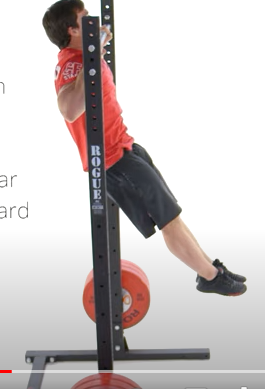The pull-up is a strength-training exercise that primarily targets the upper back, specifically the latissimus dorsi muscles. It also engages the biceps, shoulders, and core muscles.
To perform a pull-up, you need a stable overhead bar or other sturdy horizontal surface. Start by hanging from the bar with your arms fully extended and your hands placed slightly wider than shoulder-width apart, using an overhand grip. Engage your core muscles and pull yourself up until your chin is above the bar, keeping your elbows close to your body. Lower yourself back down with control to complete one repetition.
The pull-up is a challenging exercise, especially for beginners, as it requires significant upper body strength. Modifications and progressions can be made, such as using a resistance band for assistance, performing negatives (lowering yourself slowly), or working on building strength with exercises such as lat pull-downs or rows before attempting a full pull-up.
To perform a proper pull-up, it’s important to maintain good form throughout the movement. This includes keeping your shoulders down and back, engaging your core muscles, and avoiding swinging or using momentum to pull yourself up.
There are also different variations of the pull-up, including:
- Chin-up: Similar to a pull-up, but with an underhand grip, which engages the biceps more.
- Wide-grip pull-up: Performed with a grip wider than shoulder-width apart, which places more emphasis on the outer back muscles.
- Close-grip pull-up: Performed with a grip closer than shoulder-width apart, which places more emphasis on the biceps and inner back muscles.
- Commando pull-up: Performed with one hand facing forward and one hand facing backward on the bar, which engages the core muscles more.
Incorporating pull-ups into your fitness routine can help improve upper body strength, posture, and overall fitness. It’s important to start slowly and progress gradually, focusing on good form and technique to avoid injury.
Aside from the physical benefits, pull-ups also offer mental benefits, such as building confidence and discipline. As you progress and are able to perform more pull-ups, you’ll feel a sense of accomplishment and confidence in your abilities.
To improve your pull-up performance, it’s important to incorporate a variety of exercises that target the muscles used in the pull-up. This can include exercises such as lat pull-downs, rows, and bicep curls. Additionally, increasing your overall strength and decreasing body fat through proper nutrition and exercise can also help improve your pull-up performance.
It’s also important to have patience and persistence when working on pull-ups. It can take time and practice to build the necessary strength and technique, so don’t get discouraged if progress is slow at first.
In summary, pull-ups are a challenging yet rewarding exercise that offer numerous physical and mental benefits. Incorporating a variety of exercises and staying consistent with your training can help improve your pull-up performance and overall fitness.
If you’re new to pull-ups or are struggling to perform them, there are a few tips that can help:
- Practice hanging: Simply hanging from the pull-up bar for time can help build grip strength and get you used to the feeling of supporting your body weight.
- Use assistance: Resistance bands or an assisted pull-up machine can help you perform pull-ups with less body weight, making them easier to perform and allowing you to build strength gradually.
- Practice negative pull-ups: Starting at the top of the pull-up position, slowly lower yourself down to the bottom position. This eccentric movement can help build strength and get you used to the feeling of controlling your body weight.
- Don’t neglect other exercises: In addition to pull-ups, incorporating exercises that target the back, biceps, and core muscles can help improve your overall pull-up performance.
Remember, progress takes time and consistency. Be patient with yourself and focus on proper technique and form. With dedication and practice, you can build the strength and skill to perform pull-ups with ease.
It’s also important to listen to your body and avoid overtraining or pushing yourself too hard. Pull-ups are a challenging exercise that require significant upper body strength, so it’s important to gradually build up to them and not to push yourself beyond your limits.
Incorporating rest days into your training routine is also important to allow your muscles time to recover and grow stronger. It’s recommended to aim for at least one rest day per week, but this may vary depending on your individual needs and training goals.
Finally, proper nutrition and hydration are also important for building strength and improving your pull-up performance. Eating a balanced diet that includes plenty of protein, complex carbohydrates, and healthy fats can provide your body with the nutrients it needs to build muscle and recover from training. Staying hydrated by drinking plenty of water can also help support muscle function and recovery.
In summary, pull-ups are a challenging yet rewarding exercise that offer numerous physical and mental benefits. Incorporating a variety of exercises, practicing proper technique, and being patient with your progress can help you improve your pull-up performance and achieve your fitness goals.
![]()
